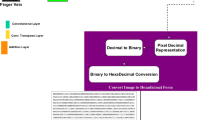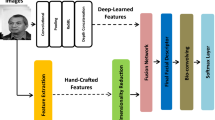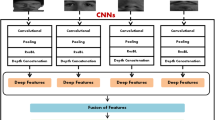Abstract
Automatic modulation classification (AMC) has recently acquired a lot of interest in the optical wireless communication (OWC) community. The OWC channel has variable characteristics. Hence, there is a need for an adaptive modulation scheme to cope with the varying channel characteristics. Adaptive modulation requires the implementation of AMC at the receiver side. Instead of using complex classification with deep learning (DL) techniques, a simple proposed scheme for AMC is introduced in this paper. This scheme is based on chaotic Baker map (CBM), wavelet image fusion, and autocorrelation estimation. It depends on constellation diagrams for eight modulation formats, including (2/4/8/16 PSK), and (8/16/32/64 QAM). First, the constellation diagrams are acquired and scrambled through the CBM, and they are merged using the wavelet image fusion and stored as reference templates in the system database. After that, the classification of each modulation format depends on estimated correlation scores and a thresholding strategy similar to the strategy adopted in cancellable biometric systems that depend on encrypted templates. Simulation results prove good classification for all studied modulation formats.















Similar content being viewed by others
Data availability
Data underlying the results presented in this paper are not publicly available at this time but may be obtained from the authors upon reasonable request.
References
Abu-Romoh, M., Aboutaleb, A., Rezki, Z.: Automatic modulation classification using moments and likelihood maximization. IEEE Commun. Lett. 22, 938–941 (2018)
Ahmed M. Elshamy, Ahmed N. Z. Rashed, Abd El-Naser A. Mohamed, Osama S. Faragalla, Yi Mu, Saleh A. Alshebeili, and F. E. Abd El-Samie, "Optical Image Encryption Based on Chaotic Baker Map and Double Random Phase Encoding," J. Lightwave Technol. 31, 2533–2539, 2013.
Al-Makhlasawy, R., Elnaby, M., El-Khobby, H., El-Rabaie, S., El-samie, F.: Automatic modulation recognition in OFDM systems using cepstral analysis and support vector machines. J. Telecomm. Syst. Manag. 3, 1–7 (2012)
Dey, A., Sing, J. K.: An image fusion technique for efficient face recognition 2015 IEEE 2nd international conference on recent trends in information systems (ReTIS), (Kolkata, India, 2015), pp. 261–266 https://doi.org/10.1109/ReTIS.2015.7232888
Eldemerdash, Y.A., Dobre, O.A., Member, S., Öner, M.: Signal identification for multiple antenna wireless systems: achievements and challenges. Appl. Opt. 18(3), 1524–1551 (2016)
El-Din Naser Mohamed, S., Mostafa, R., Khalaf, A.M.M., Dessouky, M.I., Abd El-Samie, F.: Modulation format recognition based on constellation diagrams and hough transform. Appl. Optics. 60, 9380 (2021). https://doi.org/10.1364/AO.434248
El-DinNaserMohamed, S., Mohamed, A.E.-N.A., El-Samie, F.A., Rashed, A.N.Z.: Performance enhancement of IM/DD optical wireless systems. Photon Netw. Commun. 36, 114–127 (2018). https://doi.org/10.1007/s11107-018-0761-0
Eltaieb, R.A., Abouelela, H.A.E., Saif, W.S., Ragheb, A., Farghal, A.E.A., Ahmed, H.E.H., Alshebeili, S., Shalaby, H.M.H., Abd El-Samie, F.E.: Modulation format identification of optical signals: an approach based on singular value decomposition of Stokes space projections. Appl. Opt. 59, 5989–6004 (2020)
Faragallah, O., Afifi, A.: Optical color image cryptosystem using chaotic baker mapping based-double random phase encoding. Opt. Quant. Electron. 49, 1–28 (2017). https://doi.org/10.1007/s11082-017-0909-7
Han, F., Yu, F., Han, S.: Improved baker map for image encryption. Mathematics, international symposium on systems and control in aerospace and astronautics (2006) https://doi.org/10.1109/ISSCAA.2006.1627519
Jiang, L., Yan, L., Yi, A., Pan, Y., Bo, T., Hao, M., Pan, W., Luo, B.: Blind density-peak-based modulation format identification for elastic optical networks. J. Lightwave Technol. 36, 2850–2858 (2018)
Jiang, K., Zhang, J., Wu, H., Wang, A., Iwahori, Y.: A novel digital modulation recognition scheme based on deep convolutional neural network. Appl. Sci. 10, 1166 (2020). https://doi.org/10.3390/app10031166
Keshk Me, H. M., El-Naby, M. A., Al-Makhlasawy, R. M., El-Khobby, H., Hamouda, W., W., Elnaby, M., El-Rabaie, S., Dessouky, M. I., Alshebeili, S., Abd El-Samie, F.: Automatic modulation recognition in wireless multi-carrier wireless systems with cepstral features. Wirel. Pers. Commun. 81, 1243–1288 (2015)
Lin, Y., Tu, Y., Dou, Z., and Wu, Z.: The application of deep learning in communication signal modulation recognition. IEEE/CIC international conference on communications in China (ICCC). (IEEE 2017), pp. 1–5
Liu, J., Dong, Z., Zhong, K., Lau, A.P.T., Lu, C., Lu, Y.: “Modulation format Identification based on Received Signal Power Distributions for Digital Coherent Receivers in OFC, pp. 1–3. California, USA (2014)
Liu, G., Proietti, R., Zhang, K., Lu, H., Yoo, S.J.B.: Blind modulation format identification using nonlinear power transformation. Opt. Express 25, 30895–30904 (2017)
Mandrekar, J.: Receiver operating characteristic curve in diagnostic test assessment. J. Thorac. Oncol. Off. Pub. Int. Assoc. Stud. Lung Cancer 5(9), 1315–1316 (2010). https://doi.org/10.1097/JTO.0b013e3181ec173d
Peng, S., Jiang, H., Wang, H., Alwageed, H., Zhou, Y., Sebdani, M.M., Yao, Y.: D: modulation classification based on signal constellation diagrams and deep learning. IEEE Transact. Neural Netw. Learn. Syst. 99, 1–10 (2018)
Ramadan, N., Ahmed, H., El-khamy, S.E., Abd El-Samie, F.: Permutation-substitution image encryption scheme based on a modified chaotic map in transform domain. J. Cent. South Univ. 24, 2049–2057 (2017). https://doi.org/10.1007/s11771-017-3614-6
Rani, K., Sharma, R.: Study of different image fusion scheme. Int. J. Emerg. Technol. Adv. Eng. 3(5), 5 (2013)
Samaneh, M., Puteri, S., Rahmita, W., Mohd, D., Fatimah, K., Rohollah, T.: Hybrid pixel-based method for cardiac ultrasound fusion based on integration of PCA and DWT. Comput. Math. Methods Med. 2015(1), 16 (2015)
Shun, N., Jiao, X., Yang, L., Yinghui, Z.: An image fusion method based on wavelet transform. In 2016 international conference on advanced electronic science and technology (AEST 2016) (2016) https://doi.org/10.2991/aest-16.2016.26
Soliman, R.F., El Banby, G.M., Algarni, A.D., Elsheikh, M., Soliman, N.F., Amin, M., Abd El-Samie, F.: E: double random phase encoding for cancelable face and iris recognition. Appl. Opt. 57, 10305–10316 (2018)
Thein, N., Nugroho, H. A., Adji, T. B., Mustika, I. W.: Comparative performance study on ordinary and chaos image encryption schemes In 2017 international conference on advanced computing and applications (ACOMP). Ho Chi Minh City (2017) 122–126 https://doi.org/10.1109/ACOMP.2017.25
Wang, B., Xie, Y., Zhou, C., Zhou, S., Zheng, X.: Evaluating the permutation and diffusion operations used in image encryption based on chaotic maps. Optik 127(7), 3541–3545 (2016). https://doi.org/10.1016/j.ijleo.2016.01.015
Wang, D., Zhang, M., Li, J., Li, Ze., Li, J., Song, C., Chen, X.: Intelligent constellation diagram analyzer using convolutional neural network-based deep learning. Opt. Express 25, 17150–17166 (2017)
Zhang, H., Cao, X.: A way of image fusion based on wavelet transform. 2013 IEEE 9th international conference on mobile ad-hoc and sensor networks. (Dalian, 2013) pp. 498–501 https://doi.org/10.1109/MSN.2013.103.
Zhao, Z., Khan, F.N., Li, Y., Wang, Z., Zhang, Y., Fu, H.Y.: Application and comparison of active and transfer learning approaches for modulation format classification in visible light communication systems. Opt. Express 30, 16351–16361 (2022)
Zou, K., O’Malley, J., Mauri, L.: Receiver-operating characteristic analysis for evaluating diagnostic tests and predictive models. Circulation 115, 654–657 (2007). https://doi.org/10.1161/CIRCULATIONAHA.105.594929
Funding
The authors have not disclosed any funding.
Author information
Authors and Affiliations
Corresponding author
Ethics declarations
Conflict of interest
The authors have no conflicts of interest.
Additional information
Publisher's Note
Springer Nature remains neutral with regard to jurisdictional claims in published maps and institutional affiliations.
Rights and permissions
Springer Nature or its licensor (e.g. a society or other partner) holds exclusive rights to this article under a publishing agreement with the author(s) or other rightsholder(s); author self-archiving of the accepted manuscript version of this article is solely governed by the terms of such publishing agreement and applicable law.
About this article
Cite this article
Mohamed, S.ED.N., Mortada, B., El-Shafai, W. et al. Automatic modulation classification in optical wireless communication systems based on cancellable biometric concepts. Opt Quant Electron 55, 389 (2023). https://doi.org/10.1007/s11082-022-04446-5
Received:
Accepted:
Published:
DOI: https://doi.org/10.1007/s11082-022-04446-5




